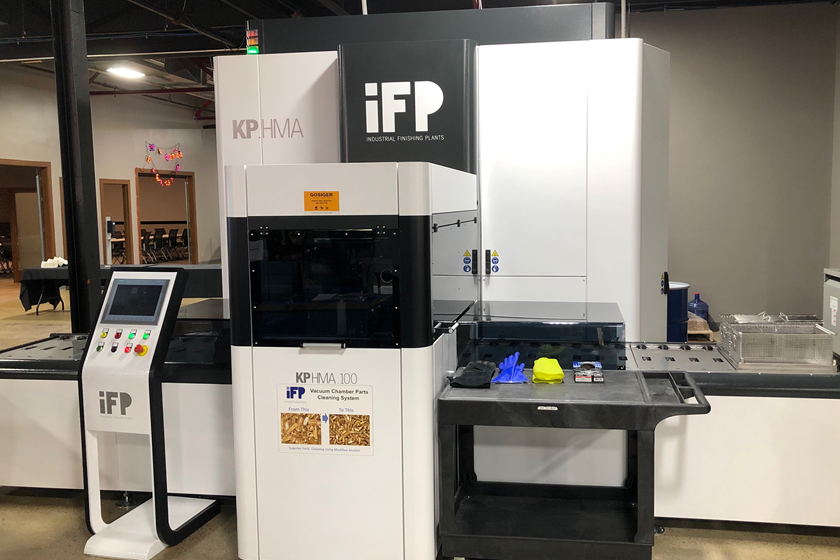Plating Clinic: Adhesion of Brush Plated Deposits
Q. How well does a brush-plated deposit adhere to the base metal?
Q. How well does a brush-plated deposit adhere to the base metal?
A. A good non-destructive test for evaluating the adhesion of electroplated deposits, unfortunately, is not available. All good tests at least partially destroy some of the deposit on the workpiece, even though there is excellent adhesion. This requires a reliance on some indirect and less-than-ideal tests. It has been found, however, that use of some or all of the following five test procedures assures, in a majority of the cases, adhesion sufficient to meet the demands of the application.
Featured Content
In longer production runs, random samples can be removed and destructively tested for adhesion. This, of course, is not practical in short runs, one of a kind jobs or on expensive parts.
Pre-qualification testing is useful in cases where sampling is not practical. For pre-qualification testing, plate a sample of the same base material. Simulate the actual job as closely as possible using the same procedures, solutions, cover materials and so on. Then, destructively test the sample. If the sample passes the test, it should give a relative assurance of good adhesion on the actual part.
Some of the best destructive tests that can be used in sampling or pre-qualification testing include the following:
Chisel, Knife and Scratch Test
If the deposit is sufficiently thick to permit the use of a chisel, adhesion is tested by forcing the chisel between the coating and basis metal. A hammer is usually used to apply the force. Thinner coatings are tested by substituting a knife or scalpel for the chisel and light tapping with a hammer may or may not be used. Very thin coatings may be tested by scratching through the coating to the base metal. After these tests, the test area is closely examined for lifting or peeling of the deposit at the base material to plating interface.
Grind and Saw Tests
Another good adhesion test is grinding an edge of the plated specimen with a grinding wheel with the direction of cutting from the base metal to the deposit. If adhesion is poor, the deposit is torn from the base. A hacksaw can be substituted for the grinder. It is important to saw in such a direction that a force is applied that tends to separate the coating from the base metal. Grinding and sawing tests are especially effective on hard or brittle deposits.
Bend Tests
When thin sections are available, bending the specimens can be a good indication of adhesion. Care should be taken that cracking of the deposit, because of brittleness, does not mean poor adhesion. The samples are either bent 180 degrees back-to-back, leaving the plating available for examination, or bent back and forth until the base material fractures. There should be no visual evidence after the bend test of plating separation from the base material. A sharp instrument should not be able to easily detach plating from the fracture area.
Some non-destructive tests that can be used are:
Tape Test
A tape test may be used to determine if the plating has very poor adhesion. The test is run on a clean, dry surface by pressing a tape, with a strong adhesive, firmly onto the surface and then snapping-off the tape as fast as possible.
Visual Test
Harder metals, in average or high thicknesses, may be visually checked for adhesion. Stress-crack lifting will be seen when poor adhesion is obtained for rhodium deposits over 2.5 micron (0.0001 in.) and nickel, cobalt, chromium and palladium deposits over 25 micron (0.001 in.) thick.
Testing has been done to obtain quantitative numbers on the adhesion of selective brush-plated deposits. The tests were run in accordance with ASTM C633-01 (2008). The test involves:
- Plating the end faces of two 1-inch diameter rods
- Cementing the plated end faces together
- Pulling on the ends of the cemented rod in a tensile test machine
The high cost of obtaining quantitative data results in the electroplating field relying heavily on qualitative tests for adhesion. The better qualitative tests involve placing the plating-to-base material interface area under high stress and strain, then observing results at the interface area. QQ-N-290B of the Federal Specification for Nickel Plating demonstrates how adhesion tests are to be performed.
Assuming that base material is properly prepared, the adhesion (tested in accordance with ASTM C633-01) of a brush-plated deposit to commonly used base materials exceeds the strength of the cement and if qualitative evidence is required, several commonly accepted methods of testing, as noted above, are available to ensure the adhesion is sufficient to meet the demands of the application.
Derek Vanek is the technical manager for Sifco; for more information, visit sifcoasc.com
RELATED CONTENT
-
Understanding Corrosion and Salt Spray
How it’s produced, NSS testing and how to get the best results possible.
-
Cleaning, Pretreatment to Meet Medical Specs ISO 13485 or FDA 21 CFR820
Maximilian Kessler from SurTec explains new practices for industrial parts cleaning, metal pretreatment and decorative electroplating in the medical device industry.
-
How to Apply the 720 Rule to Current Density Anodizing
What can you tell me about the 720 Rule as it applies to current density anodizing? Plating expert Sjon Westre, Ph.D., from Chemeon, answers this question.


















